K.M. Alexander's Blog, page 5
November 4, 2023
Open Call for 2023 Cosmic Horror Items
I need your help! Every year since 2014, I have assembled a holiday gift guide focused on cosmic horror and Lovecraftian goodies. It’s become one of my favorite annual projects. Our little corner of the horror world is full of talented creators, and I like to use the gift guide to highlight some of the fabulous weird-fiction-related items I’ve discovered throughout the year. 2023 will be no different.
That said, I am but one man, and there’s always cool stuff out there I missed, which is why I need your help. As I have for the last several years, I’m getting an early jump on assembling the guide. And it’s always worthwhile to do an open call and see what else lurks in the internet’s shadowed corners. This is that open call! Link me cool stuff! I want to know about it, and I’m sure others do too.
As always, the categories are:
Books (I generally have this covered)MusicApparel (no teeshirts—there’s a bajillion of them)GamesHousewaresMiskatonic UniversityYou can leave a comment below, message me directly, or drop me an email. (Lots of ways to connect.) Let me know what you’ve found that you think would be perfect for this year’s Gift Guide! Not everything submitted will be featured. I curate the heck out of this.
Thanks in advance!
Previous Cosmic Horror Gift GuidesBelow are links to the guides from the last eight years. Some of the products were one-offs, others are out of print, some just aren’t sold anymore. Don’t be shocked if you find broken links, especially in those earlier guides. It happens. Still, loads of cool stuff to check out.
 2022
・
2021
・
2020
・
2019
・
2018
2022
・
2021
・
2020
・
2019
・
2018

 2017
・
2016
・
2015
・
2014
2017
・
2016
・
2015
・
2014

The annual 2023 Cosmic Horror Holiday Gift Guide arrives on Black Friday, the darkest and most vile winter “holiday.” Return here in a few weeks to see this year’s thematic selection.
Tell your friends! Share with your family! Shout it from the rooftops! It’s going to be a good one.

November 2, 2023
Lovat’s Genesis: City of Darkness
The City of Lovat was born out of a thousand ideas. But its genesis can be traced to a single, almost nondescript photo I came across in 2008/09. Today, it is easy to overlook in its mundanity. It’s almost unremarkable in nature. It’s a quiet shot of an interior hallway. Exposed pipes and wires run along the ceiling. A grimy stairwell at the far end leads upward. A stack of baskets sits in a nearby corner. Two doors sit in a stained, poorly patched wall along the right side. One, a gunmetal gray, is open, and light glows from somewhere in the room beyond. The other, a green slider nearer to the camera, is closed. Colorful lanterns hang above the green door, and next to those, the day’s laundry dries. It would have been easy to move past the photo. Disregard it as just another image of a rundown building in some nameless slum. But I could see life here, even in a photo devoid of life, and it intrigued me.
 This photo from page 106 in Ian Lambot and Greg Girard’s “City of Darkness: Life in Kowloon Walled City” served as the spark of inspiration for my work. (Photo owned by Ian Lambot and Greg Girard.)
This photo from page 106 in Ian Lambot and Greg Girard’s “City of Darkness: Life in Kowloon Walled City” served as the spark of inspiration for my work. (Photo owned by Ian Lambot and Greg Girard.)After some research, lots of questions, and many internet searches, I discovered a treasure trove of inspiration. That photo was one of hundreds and came from Ian Lambot and Greg Girard’s incredible photojournalism project captured in their 1993 book, City of Darkness: Life in Kowloon Walled City. The book was a culmination of a four-year project that interviewed and documented the life of the thirty-six thousand residents who lived in a six-acre enclave in Hong Kong known as Kowloon Walled City. These days, the neighborhood and the photos thereof have penetrated the zeitgeist, but fifteen years ago, it was something a little more undiscovered and niche.
Built within the grounds of a former British fort and primarily left to its own devices, Kowloon became a legal no-mans-land for much of its existence. For a long time, it was a wooden shanty town until a series of fires turned it into something more permanent. From there, it underwent several iterations before an unregulated building boom in the 1960s turned it into a densely packed cluster of rogue apartment towers with few utilities. Electricity was often stolen. Sanitary conditions were rare. Clean water was limited, with only eight municipal pipes providing water to the entire neighborhood. Narrow alleys, cramped passageways, and a network of stairwells allowed the residents to move about the city without touching the ground. At its time, it was the densest place on the planet. Crime was rampant throughout most of its existence, though after a series of police raids, it wained in later years. Illegal doctors and dentists operated outside of the law beneath the shadows. But despite its seedier side, many people also lived, worked, and raised families here. They formed a community—for thousands, it was home.
I got my hands on a borrowed copy of The City of Darkness and poured through its pages. Finding more and more photos revealing more and more corners of this fascinating place. When I found the picture that had initially sparked my quest (page 106, which you can see above), the caption beside it was illuminating and only added to my initial inspiration.
With complete disregard for any recognized concept of zoned planning, factories and family apartments were to be found side by side through the city, sharing and spilling out onto communal alleyways. In one corridor, the products of the local plastics factory were being packaged; in another, the family washing was put out to dry.
City of Darkness: Life in kowloon Walled City – Ian Lambot and Greg Girard
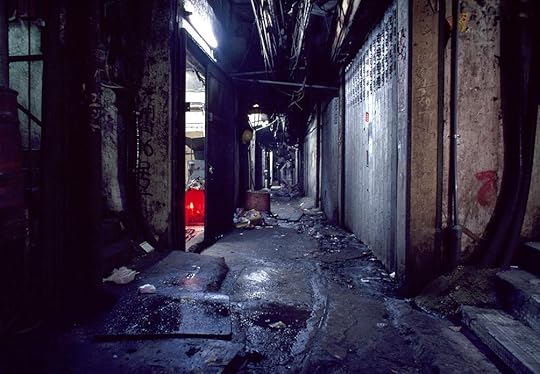
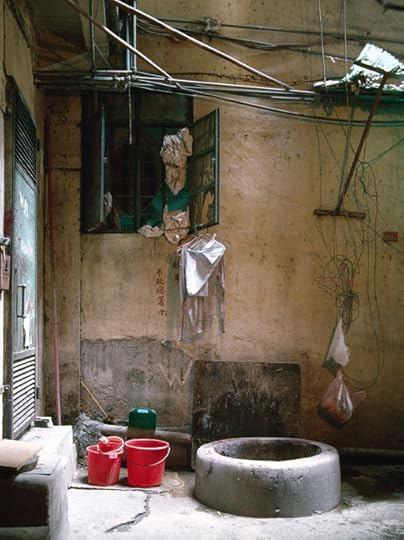
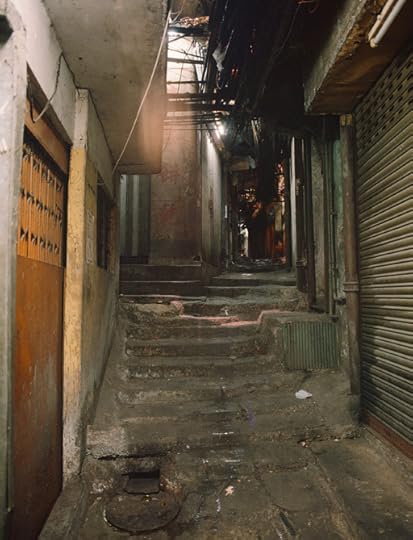
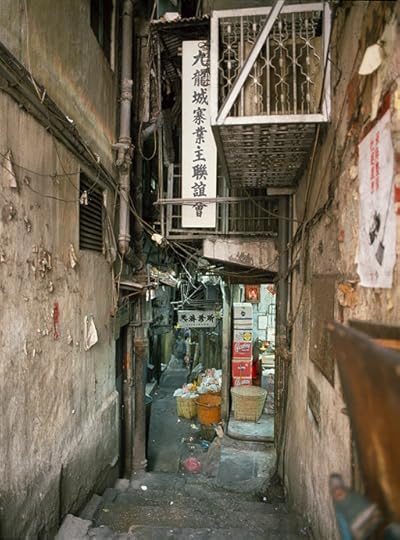
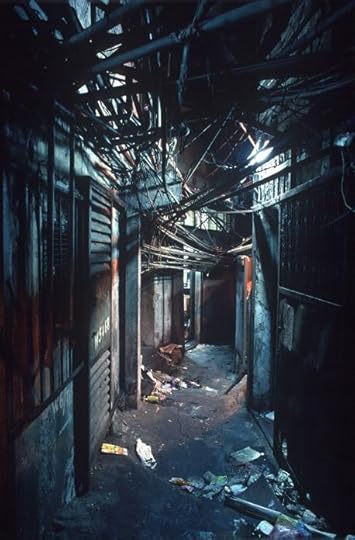
I spent a lot of time looking through the book. I studied Lambot and Girard’s photos intently, and I read the accounts from the inside. Over time, it formed the crux for Lovat—a writer taking Kowloon Walled City to the extreme. A multileveled city of warrens where life happened without city planning, and the rule of law felt more reactionary. A system that, despite the apparent dangers, still somehow functioned and even thrived. I saw it unfurl before me: a haphazard megalopolis emerging from an apocalypse built on the back of a much older city, as much cyberpunk as steampunk. And what better way to explore that world than following an innocent man on the run accused of a crime he didn’t commit, moving through that city as he works to clear his name? Lovat became a character to me, as alive in my mind as Waldo Bell, Wensem dal Ibble, or any of the characters that would come later.
Kowloon Walled City was cleared and torn down between 1993 and 1994, and today, the site is home to Kowloon Walled City Park. But the images and experiences of the haphazard city of thirty-three thousand people who called it home live on. While the original book is long out of print, there is a new edition available, City of Darkness Revisited, showcasing life within that fascinating place. I recommend picking it up. Flipping through its pages, you can see how Kowloon Wall City’s existence came to inspire so many video games, films, and books, including my own.
This year, I’m celebrating the 10th anniversary of The Stars Were Right, the first book in The Bell Forging Cycle. It’s a Lovecraftian urban fantasy set within and around the phenomenal city of Lovat, my fictional version of Kowloon Walled City. In some ways, it’s a love letter to a place I was never able to visit but found fascinating and inspiring. That genesis grew from a quiet photo capturing a moment in time of an inconspicuous hallway in a rogue enclave that no longer exists.
October 25, 2023
Weird Fiction Explained
This quick video is a great little primer on the historical origins of weird fiction from Moid Moidelhoff and his (excellent) YouTube channel, Media Death Cult. If you’re a fan of my work, you’re a fan of weird fiction, and this is an excellent synopsis tracking weird fiction as it grew from Edgar Allen Poe’s mid-19th century work to blossom into the New Weird fiction we see today.
October 21, 2023
THE STARS WERE RIGHT for 10 Years!
Somehow, October 1st was the 10th Anniversary of the release of The Stars Were Right, the first book in The Bell Forging Cycle, the novel that introduced my readers to caravan master and always-hungry Waldo Bell, the multilevel megalopolis of Lovat, and the cosmic horror-soaked world of the Territories. Like a Lovecraftian monstrosity, it totally crept up on me! How has it been ten years already? Didn’t I just release this thing?
On the day of the release, Kari-Lise organized a release party at Brouwers, a great flemish pub here in Seattle. A bunch of friends came out, and we all celebrated. My buddy Steve Leroux did a dramatic reading of the prologue for everyone. (I was still figuring out the whole author-doing-their-own-reading-thing, really the whole author thing, truth be told.) It’s a fond memory, and I am grateful for the people who helped me commemorate the occasion. Who knew the places it’d go, eh?
 Managed to find a photo of release night on an old Instagram account of Kari-Lise’s
Managed to find a photo of release night on an old Instagram account of Kari-Lise’sback when Instagram was barely a thing.
So much has happened since that first book. The Bell Forging Cycle is now a series, and between those books, my Old Haunts and Quiet Corners, other ephemera, as well as the ARG, the world of the Territories has expanded significantly from that first little novel. I had always had the idea of a trilogy, but even as I began to write the second book, Old Broken Road, I could see it was going to grow into something larger.
Over the next few weeks, I am going to reminisce on those early days. Reflect on inspirations, look at some great fan art, and share some fun new things along the way. Along with those reflections, and to celebrate The Stars Were Right being a decade old, I have put each of the first three ebooks in The Bell Forging Cycle on sale for ONLY 99¢! That’s less than the regular price of The Stars Were Right for not one, but THREE books. The links below will take you to the sale for the ebook reader of your choice.
Kindle • Kobo • Nook • Apple Books • GooglePlay
If you have been following this blog and never checked out my books, now is the perfect time. You can start the series for less than three dollars. If you’re a long-time reader (thank you), now you have an easy way to convince your friends to check out The Bell Forging Cycle!
Were you one of my regular readers from the very beginning? Or did you only recently discover my work? How’d you hear about The Stars Were Right? Let me know in the comments!
September 19, 2023
Moronobu Gansai: A Free 17th Century Cartography Brush Set for Fantasy Maps
The Tōkaidō was the most important of the Gokaidō (Five Routes/Highways) administrated by the ruling Tokugawa shogunate during the Edo Period. Running along the coast of Honshu, this road linked the shogunate’s capital of Edo with the imperial city of Kyoto. Along this route were fifty-three government post stations where travelers had to show their traveling permits and pay their toll before continuing. The route was so famous that traveling its length was a popular subject in art and literature of the period, and many travelogues and guidebooks were published and, of course, maps.
The history and culture that surrounds the Tōkaidō is fascinating, and I highly recommend exploring it further, but it’s because of those maps that I am launching my newest collection: The Moronobu Duo. Today, I am releasing the first of two sets based on the 17th-century work of Hishikawa Moronobu, both focused on the Tōkaidō. Because I launched Ishikawa earlier this year, I’m naming these sets after Hishikawa’s given name to avoid confusion. This first set, Moronobu Gansai, comes from his beautiful ink and watercolor 東海道分間絵図 (Map of the Tōkaidō), a stunning road map that was painted on a pair of scrolls, each around sixty feet long and was based on the cartography of Ochikochi Dōin.
All my Map Tools will always be free. Want to help support this work?
Click here to learn how.
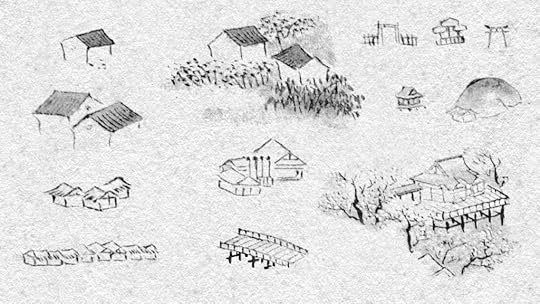 A sample of the settlement buildings and objects you’ll find in Kensett
A sample of the settlement buildings and objects you’ll find in KensettEach section is exquisite, and while still technically a map, much of Hishikawa Moronobu’s work here is reminiscent of picturesque landscapes rather than a standard map. Lovingly painted and layered with color, the whole route comes alive to the viewer. That doesn’t make it easy for brush sets. I knew it would take some time, but with a little work, I was able to pull the color so I could extract the signs and symbols to create the set I’m sharing with you today. It’s filled with loads of little details that bring the road to life. Shrines huddle in groves of trees, bridges span streams, shops line roadways, and mountain vistas (and the ever-present Mt. Fuji) dominate the horizon. It’s all fantastic and would work perfectly for building out a unique fantasy map.
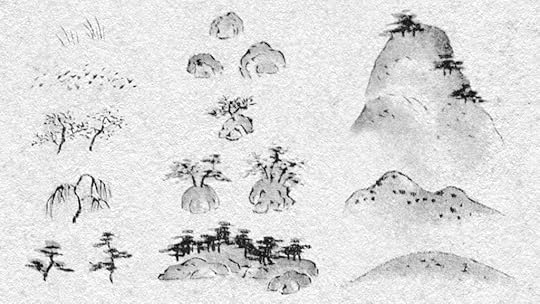 Some of the flora and landform brushes.
Some of the flora and landform brushes.There are some distinctive symbols found in this set that you don’t find in Western sources. For example, the mounds or rocks with trees growing from them would be depicted flanking the road at intervals. These served as milestones and distance markers for travelers and were common on the Tōkaidō. When travelers came to post stations, they would find them marked on a map with little clusters of signs (usually three). These most likely represented the Kōsatsu or “high plaques” where travelers could find the shogun’s proclamations. Notable traders, brokers, and tea houses would be described and labeled, as well as the station’s travel fees.
 More of Moronobu Gansai’s brush offerings
More of Moronobu Gansai’s brush offeringsWith so much to draw from, Moronobu Gansai is the biggest set I’ve ever released. Inside, you’ll find over one thousand one hundred forty brushes covering a range of objects to build out your map. The style of the map—painted on enormous scrolls—means some of these shapes and symbols are, in particular, quite wide, so be forwarned. Some of my favorites were too big to display in the samples above. Inside Moronobu Gansai, you’ll find:
50 Individual Buildings20 Building Pairs25 Building Clusters80 Building Rows15 Building w/ Evergreens30 Buildings with Cherry Trees15 Schools50 Bridges42 Signs11 Fortresses10 Statues & Monuments24 Torii Gates27 Shrines02 Shrines w/ Gates21 Shrines w/ Trees07 Shrines w/ Mountains04 Large Shrines03 Boats35 Unique Settlements20 Fields12 Grasses20 Low Foliage100 Cherry Trees11 willow Trees20 Deciduous trees35 Individuals Evergreens110 Small Groups of Evergreens40 Large Groups of Evergreens14 Ponds04 Swamps25 Water Flora35 Rocks90 Rocks w/ Trees127 Mountains05 Birds55 CloudsThe button below links to a ZIP file that contains a 31 MB Photoshop ABR brush set (it’ll also work with GIMP, Affinity Photo, and I’m told Procreate now). And, for the first time, I am also releasing the set as a pack of individual PNGs organized by folders the same way I organize the ABR files. This should make using these with tools like Wonderdraft much easier. No more extracting symbols from an enormous PNG!
Like this set? Click here to learn how you can support this project.
DOWNLOAD Moronobu GansaiDownload the Moronobu Gansai PNG Pack
(48 MB)
As with all of my previous brush sets, Moronobu Gansai is free for any use. I distribute my sets with a Creative Common, No Rights Reserved License (CC0), which means you can freely use this and any of my brushes in personal or commercial work and distribute adaptations. No attribution is required. Easy peasy!
Enjoy Moronobu Gansai? Feel free to show me what you created by emailing me. I love seeing how these brushes get used, and I’d be happy to share your work with my readers. Let me see what you make!
Moronobu Gansai in UseWant to see how I’ve used this set? I created a sample map below so you can see how these brushes can be used. There are three versions: a colored example, a black-and-white rendition, and a decorated sample. Click on any of the images below to view them larger. Perhaps this will inspire you as you get started on your projects!
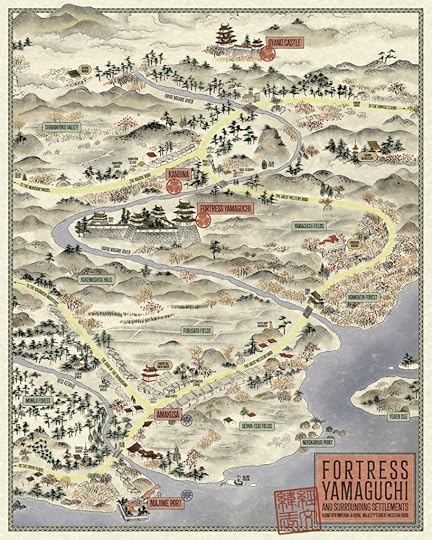 4000×5000 (19.5 MB)
4000×5000 (19.5 MB)
 4000×5000 (13.5 MB)
4000×5000 (13.5 MB)
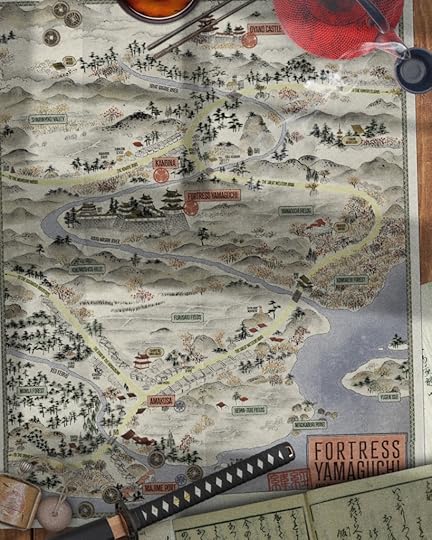 1080×1350 (2 MB)
1080×1350 (2 MB)Sample Details: The font is Espiritu Condensed, which I licensed through Adobe Fonts. I use Kyle’s Watercolor Brushes for the color effects. The mon emblems came from Wikipedia, as did the Tokugawa shogunate seal. The paper texture is from True Grit Texture Supply’s Infinite Pulp, and they’re also where I got Atomica, which gives me ink-like effects for the text, the roads, the borders, basically everything—big fan of their tools.
Support this WorkBrushes and tools released through the #NoBadMaps project will always be free and released under a public domain CC0 license. If you’d like to support the project and help me cover the cost of hosting, research, and tool-set development, I’ve put together three ways you can help, and all are detailed below.
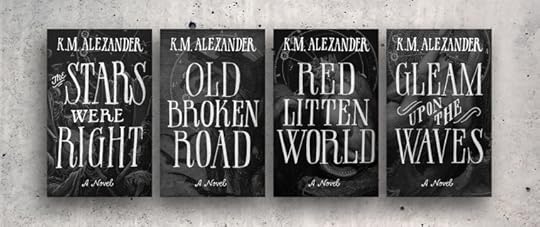 Buy My Books→
Buy My Books→
I’m not just a map enthusiast. I’m also a novelist! The easiest way to support me (and get something in return) is by purchasing one of my cosmic horror urban fantasy novels.
❦
 Buy Me a Coffee→
Buy Me a Coffee→
A simple and quick way to support the #NoBadMaps project is through a one-time donation of any amount via ko-fi. Your support helps keep this project going and is appreciated.
❦
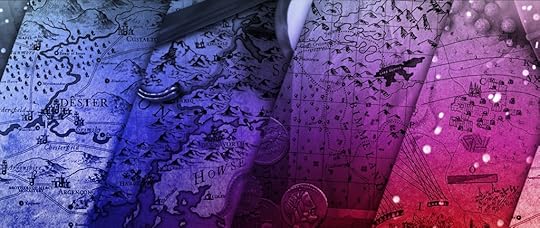 Join my Patreon→
Join my Patreon→
If you want to continually support the #NoBadMaps project through a reoccurring monthly contribution, consider joining my Patreon and get sneak peeks into what’s coming.
❦
More Map BrushesThis is just one of many brush sets and map tools I’ve released. You can find it and other free brushes covering a wide variety of historical styles on my Fantasy Map Brushes page. Every set is free, distributed under a CC0 license, and open for personal or commercial use. I’m sure you’ll be able to find something that works for your project. Click the button below to check them out!
view more Fantasy Map Brushes
Want to stay in touch with me? Sign up for Dead Drop, my rare and elusive newsletter. Subscribers get news, previews, and notices on my books before anyone else delivered directly to their inbox. I work hard to ensure it’s not spammy and contains interesting and relevant information. Sign Up Today →
September 13, 2023
Visual Tour Through Tolkien’s Map of Middle Earth
This wonderful little video from Mapster’s Great Maps Explained series showed up in my feed yesterday, and I figured it’d be a good one to share here with my regular readers. Christopher Tolkien’s map of Middle Earth has become iconic among SFF enthusiasts, and this video takes the viewer on a wonderful little visual tour through the regional map published in J. R. R. Tolkien’s 1954 edition of The Fellowship of the Ring. It’s full of loads of details with nods to history, both real and imagined. If you’re a fantasy fan, a Tolkien fan, or just a map fan (or, like me, all three), it’s worth checking out.
August 31, 2023
The State of the Cycle 2023
When I started this blog, I told my then-nonexistent readers that this would be a living document of the life of an aspiring novelist: the ups and downs, the positives and negatives, the fears and hopes, and all the emotions that go along with putting yourself out there creatively. But, over the last few years, I’ve done less of that, and looking at it from the outside, I feel like talking less about the work has decoupled me from my writing in ways I don’t like. I have been wanting to address this; the best way I could think was to write my way through it.
I’ve been dwelling on this for a while, and I’ve been putting off this particular post for some time, mainly because it’s not all sunshine and roses. It feels like it’s important, however. A good place to start my re-engagement. For the past few years, I received emails from various readers asking how things are going and if there will be more Bell Forging Cycle books in the future. Those questions asked are valid, and while I have given some standard answers, a more detailed response is well overdue. It’s past time I address these questions, discuss where I am with the series, talk about where it’s going, and explain what else is happening. Welcome to the State of the Cycle, 2023.
Where Do Things Stand?Book IV, Gleam Upon the Waves, is out, and it’s been out for a while. I’m proud of it. I believe it’s my best work. What reviews it has gotten have been positive, but sales have been relatively slow. I’m not completely surprised. It’s the fourth book in the series, and generally, a fourth book will rank (surprise) fourth sales-wise. It’s the nature of a series. Only some people will continue with a series after the first novel, and readers will continue to fall off as books come out.
I’ve been doing this long enough that I’m not completely discouraged by this. Not every book can be a best-seller, especially the fourth in an obscure and admittedly niche weird-fiction series like The Bell Forging Cycle. I understand that intellectually, and I’ve come to terms with it. But it’s hard not to be haunted by a specter of disappointment. Novels take time, and it’s somewhat disheartening when they land with a whimper. That can have a ripple effect on a writer’s engagement and productivity.
I worry that sounds more morose than I feel, but it’s essential to acknowledge that those emotions linger and can affect production even after you think you’ve come to terms with them. I know other artists across mediums who have faced similar discouragement. Lately, I felt that for me addressing this issue head-on, as I’m doing here, is the better solution. Acknowledge the challenge, put it out there, then deal with it. So yeah, having the last two books launch and quickly sputter out has been a bummer. But I love this world and its characters, and I want to tell its story. If I wanted to write mainstream fiction, I could have. Deep down, my love for my weird little series goes beyond the sales. My goal is and has always been to finish the hexology. There’s a story to finish, and I will do that. This means two more books are on the docket; they’re planned, and they’re coming.
When is the Next Book Coming?The honest answer: I don’t know. Sometime. But there’s still a lot of writing to do. In the last year, writing for me has been ponderously slow and, for some months, completely nonexistent. Some of that is due to everything I mentioned above. But another part is that writing remains a side gig, and real life and my day job take precedence. I’ve been very lucky at how well the series has sold, but this is still a labor of love.
That said, I am over a quarter of the way through Book V. I’m still excited by it. It will be weird and different, but still, the same Waldo Bell adventure that keeps all of you reading. I won’t go into a lot of details, but we’re leaving the levels of Lovat behind us and heading deep into the Territories. It should be fun and a little horrific. By the time you get to the fifth book in a series, there are a lot of strings, and strings mean knots and those tangles can be complex, which means they’ll take a bit of work to unravel.
There’s good news about all of this. A few weeks ago, I spent a weekend doing a writing retreat on Whidbey Island, and while I didn’t hit the word count I wanted, immersing myself back into the series allowed me a fresh perspective. I managed to untangle some of those knots. I see a way forward, which I haven’t been able to say in months. I have another retreat in October and plan to continue building on that momentum. It’s steps in the right direction, and I’m excited.
Years ago, you talked about a novella. Where is it?Oh, yeah. I did. Didn’t I? That didn’t pan out as I hoped, and I probably jumped the gun on announcing it. The goal was to write a story from Wensem’s perspective during the events of Red Litten World, but I never managed to achieve the voice I wanted. He works better as a strong silent type, not as a narrator. It had some intriguing ideas, and I have a chunk of it complete. I might revisit it if the muse strikes, but I want to focus on Book V for now.
But there is a silver lining to this as well. Instead of the novella, I ended up writing five interconnected vignettes set in the world of the Territories. The plan (right now, at least) is to have each of these appear as five Interludes scattered throughout Book V. Regular readers might remember that I read the first one during the pandemic for King County Library’s Barely Tolerable Tales. It was a weird one, and they only got more bizarre. They’ll be an excellent addition to the narrative. If there’s enough excitement, I might release them on their own before Book V’s launch.
Okay. So, how can I help?If you’re reading this blog, you’re already doing it. Your support keeps me writing. Your emails, comments, reviews (text, video, whatever!), and ratings help me tremendously. I can shout about it from the rooftops, but your friends don’t know me from Carter. If you recommend my books, it’ll go much further than any marketing or promotion I can do. (And believe me, I’ve done a lot.)
What’s next in 2023 (and beyond, really?)As I’m typing this, it is still August, but the last few days in Seattle have felt very autumn-like. It’s currently low-60s and raining outside. The harried nature of summer in Seattle always tends to dwindle as September rolls around, and I relish this time.
What am I doing this Fall? I’m planning to write, mostly. I also have a few editing projects, which might lead to something more. But the writing will be the priority.
I am still planning out what will be the 10th Annual Cosmic Horror Holiday Gift Guide for 2023. (I can’t believe I’ll have been doing this for a decade.) It’s always my most significant post of the year, and readers love it. So expect another entry full of all sorts of Lovecraftian stuff. I already have a lot of great products stashed away, but feel free to message me with anything you think would be a good fit.
Unexpectedly, my free fantasy map tool sets have become the most prominent traffic draw to this blog. Last year was my most significant year traffic-wise; this year is on track to blast past that. I never expected #NoBadMaps to take off the way it has. Thousands of people come here to download my toolkits, and seeing the work they do with the assets I’ve assembled has been humbling. I have Patreon supporters now! Plus, I find building them out is both relaxing and good brainstorming time. It’s become a place of zen for me. I will probably have a few more released before the year is out.
Also, plan on a few more Raunch Reviews because those fake swear words aren’t going to review themselves.
I have a few other ideas that seem daunting right now. In the last few years, quality hardcovers have become easier to produce, and I am tempted. I’ve gotten good enough with audio editing that it could be fun to produce some audiobooks. Not totally sure about the demand for either, but both are things I’m considering.
In ConclusionSo, that is my report on the State of the Cycle. The last few years have been more of a struggle than I anticipated, but I am optimistic about the future. Honestly, outside of nebulous timelines and some disappointing sales figures, this post could have gone a lot worse. As I’ve mentioned earlier, I count myself very lucky as a writer.
I wish I could provide more exact dates, but those will come in time. For now, it’s nice to talk with you about the work, the challenges I’ve recently faced with writing, and what I am doing to solve them. In many ways, I am writing this post for myself as a way to acknowledge my current state. The best way out was through, and I plan to push on.
As I mentioned during my One Thousand milestone moment back in July, I’ve accomplished a lot since Gleam Upon the Waves. It may not all be writing-related, but it’s still creative. I’m proud of the work I’ve made, what I’ve published here, and the fantasy cartographers I’ve inspired. I will keep doing more projects like this, but I plan to prioritize my writing going forward.
If you made it this far, thanks. I appreciate you.
Lots to come. Stick with me. The cycle rolls on.
July 27, 2023
All My Sample Maps in One Handy Location
Since I started #NoBadMaps, I’ve been looking for various ways for users to key in on a particular style of map they want to build. Most of this has been built around my brush sets’ eras. But knowing you want a 16th or 17th-century-styled map requires some foreknowledge. And I didn’t supply a way to look at the style of brushes without visiting each set. That’s not ideal, and I am changing that today.
Last week I launched a new Sample Fantasy Map page. This is a new repository showcasing all the sample maps I have made over the years. This will allow the aspiring fantasy cartographer to hone in on the style of a map style they are looking for while comparing them against other sets quickly.
Along with an easy way to browse all my sample maps, I include other details about each sample map’s construction—font choices, texture selections, and even naming schemes listed. So if you’re looking for a particular feel, this is the perfect page to browse the sets and glean information without going and downloading each set to see what’s included.
I never expected these to blow up the way they have over the last few years. So I only kept track of a few of my choices early in this project. But will work to backfill as much information as possible. You can access this page from the primary Fantasy Map Brushes page. As always, if you have any questions, let me know. I’m happy to help as best I can
Happy Mapping, everyone!
Support this WorkBrushes and tools released through the #NoBadMaps project will always be free and released under a public domain CC0 license. If you’d like to support the project and help me cover the cost of hosting, research, and tool-set development, I’ve put together three ways you can help, and all are detailed below.
 Buy My Books→
Buy My Books→
I’m not just a map enthusiast. I’m also a novelist! The easiest way to support me (and get something in return) is by purchasing one of my cosmic horror urban fantasy novels.
❦
 Buy Me a Coffee→
Buy Me a Coffee→
A simple and quick way to support the #NoBadMaps project is through a one-time donation of any amount via ko-fi. Your support helps keep this project going and is appreciated.
❦
 Join my Patreon→
Join my Patreon→
If you want to continually support the #NoBadMaps project through a reoccurring monthly contribution, consider joining my Patreon and get sneak peeks into what’s coming.
❦
July 17, 2023
Five Dollar Words
“Don’t use a five-dollar word when a fifty-cent word will do.”
Mark Twain
This quote came to me while I was out for a walk this morning and listening to an audiobook. I wondered if I had shared it here before, and I hadn’t, so I am fixing that oversight now. It’s a piece of writing advice that gets stuck in my head as I work. Perhaps it’ll get stuck in yours as well.
July 13, 2023
Kensett: A Free 19th Century Urban Cartography Brush Set for Fantasy Maps
There’s a style of cartography that is hard for the modern viewer to wrap their head around. Most of the time, we expect a broad macro perspective. Seeing the world from a single angle. But it was not uncommon for cartographers to map locations based on perspective. Such is the case with today’s subject. Instead of showing a town from above, we get renders that show how the village would look from the street. Which street? Well, every street.
It’s been a while since I released an urban-focused brush set, and today we’re going to fix that. Kensett is a new urban cartography brush set based on the work of Thomas Kensett, the patent holder of the tin can, a freemason, and a cartographer and engraver. In particular, we’re taking his work on A plan of the town of New Haven from 1806, based on James Wadsworth’s survey from 1748, and made shortly after Kensett immigrated to the United States. (It’s very possible he was an illegal alien at the time.)
All my Map Tools will always be free. Want to help support this work?
Click here to learn how.
 A sample of the shacks, houses, and barns you’ll find in Kensett
A sample of the shacks, houses, and barns you’ll find in KensettThere’s a lot to love here. With hundreds of houses, their lots and land, inhabitants, and various outbuildings all rendered and labeled. The style is charming and unique—could even use the word quaint—and perfect if you’re looking to map a make of a village or a small town. Kensett engraved each building as their front doors aligned to the street, and his buildings sprawled in all directions. More prominent buildings are rendered more intricately, while more mundane structures like barns and shacks are a few lines and some shading. That approach gives the original map a whimsical flair that works perfectly for a small town.
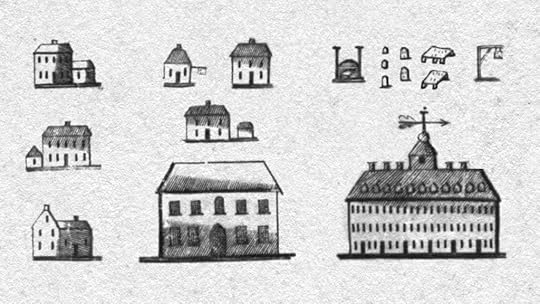 More of Kensett’s building brush offerings
More of Kensett’s building brush offeringsIt’s a thorough set. When I build a brush pack, I extract brushes at maximum resolution. As a result, the brushes here are quite large. Significantly so. (As you can see in the samples above.) In my sample map below, itself a large document, I worked with them reduced by fifty percent. I included as much as I could, I righted all the buildings, and in the zip file, you’ll even find a list of professions taken from 18th Century New Haven.
This set isn’t my largest, but I was surprised at how big it became when all the elements were extracted. With over 380 brushes, inside Kensett, you’ll find:
15 Shacks46 Small Houses106 Regular Houses13 Large Houses8 Inns12 Unique Buildings8 Sheds6 Heated Barns106 Barns2 Cemetary Brushes28 Blank Gravestones21 Marked Gravestones4 Ledger Stones5 Unique Gravestones7 CartouchesThe button below links to a ZIP file that contains a Photoshop brush set (it’ll also work with GIMP, Affinity Photo, and I’m told Procreate now) as well as a large transparent PNG (3 Mb), in case you’re using a program that doesn’t support Adobe brush files. They’re black and on a transparent background, so they’ll look broken in some browsers, but trust me, they’re all there. Like this set? Click here to learn how you can support this project.
DOWNLOAD KensettAs with all of my previous brush sets, Kensett is free for any use. I distribute my sets with a Creative Common, No Rights Reserved License (CC0), which means you can freely use this and any of my brushes in personal or commercial work and distribute adaptations. No attribution is required. Easy peasy!
Enjoy Kensett? Feel free to show me what you created by emailing me. I love seeing how these brushes get used, and I’d be happy to share your work with my readers. Let me see what you make!
Kensett in UseWant to see how I’ve used this set? I created a sample map based on the town of Derry from Stephen King’s incredible 1986 horror novel It. (Link goes to IndieBound. Pick it up!) It was fun to reimagine the Derry Township several hundred years before Pennywise terrorized the Losers. It’s not canon, so think of this as Derry on another level of the tower.
There are three versions, a colored, black and white, and a decorated sample. Click on any of the images below to view them larger. Perhaps this will inspire you as you get started on your projects!
 4000×3000 (14 MB)
4000×3000 (14 MB)
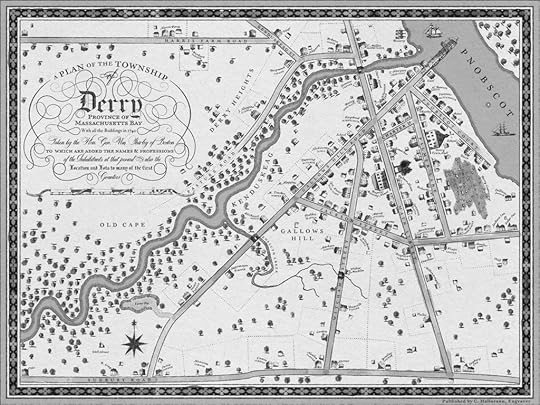 4000×3000 (9 MB)
4000×3000 (9 MB)
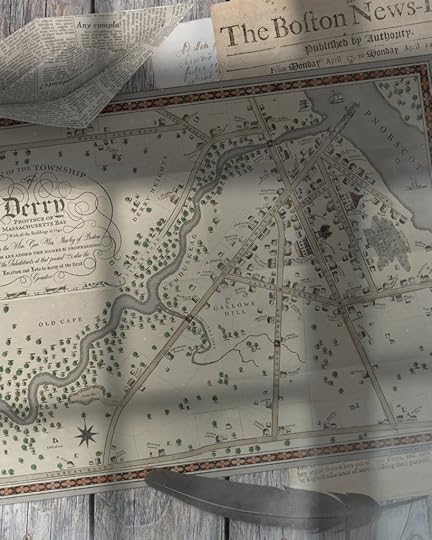 1080×1360 (1 MB)
1080×1360 (1 MB)Sample Details: The fonts used are MVB Sirenne for the household names and professions, the script font is DomLovesMary, and both are licensed through Adobe. Harbour is the typeface used for the “Derry.” The flora is taken from Homann. I use Kyle’s Watercolor Brushes for the color effects. The paper texture is from True Grit Texture Supply’s Infinite Pulp, and they’re also where I got Atomica, which gives me ink-like effects for the text, the roads, the borders, basically everything—big fan of their tools.
Support this WorkBrushes and tools released through the #NoBadMaps project will always be free and released under a public domain CC0 license. If you’d like to support the project and help me cover the cost of hosting, research, and tool-set development, I’ve put together three ways you can help, and all are detailed below.
 Buy My Books→
Buy My Books→
I’m not just a map enthusiast. I’m also a novelist! The easiest way to support me (and get something in return) is by purchasing one of my cosmic horror urban fantasy novels.
❦
 Buy Me a Coffee→
Buy Me a Coffee→
A simple and quick way to support the #NoBadMaps project is through a one-time donation of any amount via ko-fi. Your support helps keep this project going and is appreciated.
❦
 Join my Patreon→
Join my Patreon→
If you want to continually support the #NoBadMaps project through a reoccurring monthly contribution, consider joining my Patreon and get sneak peeks into what’s coming.
❦
More Map BrushesThis is just one of many brush sets and map tools I’ve released. You can find it and other free brushes covering a wide variety of historical styles on my Fantasy Map Brushes page. Every set is free, distributed under a CC0 license, and open for personal or commercial use. I’m sure you’ll be able to find something that works for your project. Click the button below to check them out!
view more Fantasy Map Brushes
Want to stay in touch with me? Sign up for Dead Drop, my rare and elusive newsletter. Subscribers get news, previews, and notices on my books before anyone else delivered directly to their inbox. I work hard to ensure it’s not spammy and contains interesting and relevant information. Sign Up Today →



